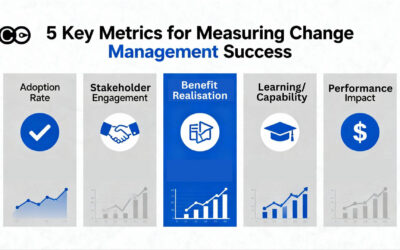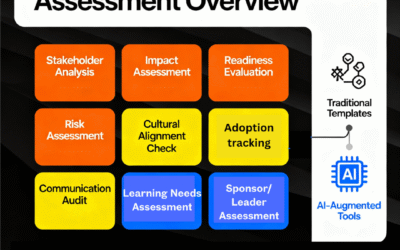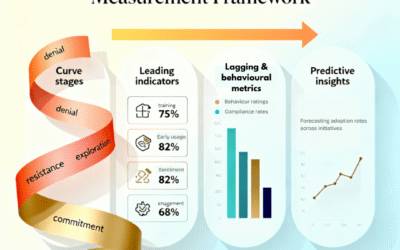The Stockholm Syndrome in Change Management Teams
Change management teams have long prided themselves on enabling organisations to adapt, evolve, and thrive in the face of constant disruption. Yet, a curious irony persists: many change management teams themselves are reluctant to change. They are trapped in a cycle of executing individual projects, refining legacy methodologies, and building capabilities through workshops and sessions-year after year, with little evolution in their own practice. This phenomenon can be described as “Change Management Teams’ Stockholm Syndrome”-where practitioners defend the very systems and routines that may be limiting their impact, just as employees in transformation-fatigued organisations do.
This syndrome is not just about comfort; it is also about fear. Changing the way change is managed is risky. There is a real concern that if things do not go well, the change team may be blamed. The prevailing attitude is often: “If everyone else is doing it this way, why should we change?” This mindset is a significant barrier to progress and innovation.
And this is not to specifically single-out change management teams. In the corporate world, process and methodology helps to create certainty and clarity. Without it, there could be chaos. As a result, organisations as a whole and its teams, tend to stick to the convention to run the business.
The Legacy Methodology Trap
Most change management teams remain wedded to legacy methodologies-structured, linear frameworks that were designed for a pre-digital era. These approaches often emphasise process over people, form over function, and documentation over data. While these methods have served organisations well in the past, they are increasingly mismatched with the realities of today’s digital and AI-driven world.
The result? Change management teams risk becoming irrelevant, unable to provide the strategic value that modern organisations demand. They are seen as facilitators rather than strategists, focused on executing rather than shaping change. This legacy focus also means that teams miss out on the benefits of agile, data-based approaches that are now commonplace in other disciplines such as marketing, operations, human resources and customer experience.
The Cost of Standing Still
The consequences of this stagnation are profound:
- No Innovation: Without evolving their own practices, change management teams cannot credibly advocate for innovation elsewhere in the organisation.
- Legacy vs. Agile: Teams remain focused on rigid, legacy methodologies, missing opportunities to leverage agile, iterative, and data-driven approaches that are better suited to today’s fast-moving environment.
- No Data-Based Insights: Historical data is often ignored, meaning teams cannot learn from past successes or failures, nor can they provide predictive insights to guide future change initiatives.
- Inability to Influence Strategically: Without data and digital fluency, change teams struggle to influence at a strategic level, limiting their ability to shape the direction of the organisation.
- Credibility Challenges: Project teams and leaders may increasingly question the value of change management, seeing it as a bureaucratic function rather than a strategic partner. On the other hand, change managers spend significant time on arguing/positioning their worth, versus delivering value.
The New Digital and AI Reality
The world has changed. Digital transformation is no longer a buzzword-it is a reality. AI is reshaping how work gets done, automating routine tasks, and providing deep insights that were previously unimaginable. Other disciplines have already embraced these trends, using data to inform decisions, automate low-value work, and focus on high-value strategic activities.
Yet, many change management teams are still operating in a pre-digital mindset. They are not leveraging the power of automation, AI, or data analytics to transform their own work. This is not just a missed opportunity-it is a threat to the relevance and impact of the discipline.
The Comfort of the Familiar
Why do so many change management teams resist changing their own ways of working? The answer lies in what we as change practitioners already know about human psychology. Change is hard, even for those who advocate for it. The status quo is comfortable, and the risks of trying something new are real. Teams may fear failure, blame, or simply the unknown. They may also suffer from “Organisational Stockholm Syndrome,” defending the very systems that exhaust them and limit their potential.
Looking Ahead
The solution is clear: change management teams must catch up with industry trends that other disciplines have already embraced. They must leverage data to inform their work, automate lower-value tasks, and leapfrog to higher-value strategic roles-advising on change strategy, adoption, and benefit optimisation across the organisation. Only by transforming themselves can they credibly support the transformation of others.
Barriers and Breakthroughs in Digital Change Management
Facing the Realities of Digital and Data-Driven Transformation
As change management teams recognise the need to evolve, they encounter a complex array of barriers that are both technical and cultural. The journey toward digital and data-driven change management is not simply about adopting new tools or methodologies; it is about transforming mindsets, processes, and organisational structures. The following barriers are among the most persistent and impactful.
Key Barriers to Digital and Data-Driven Change Management
- Resistance to Change
- Even within change management teams, resistance is a formidable obstacle. Many practitioners are comfortable with established processes and fear the disruption that comes with new digital tools or methodologies. This resistance is compounded by concerns over job security (e.g. the result of AI and automation), the risk of failure, and the potential for blame if initiatives do not succeed.
- Integration with Legacy Systems
- Many organisations rely on outdated systems that are not designed to work with modern digital solutions. Integrating new technologies-such as AI-powered analytics or automation platforms – with legacy processes such as spreadsheets and templates that are often complex, time-consuming, and costly. This challenge can stall progress and limit the ability to leverage data-driven insights.
- Lack of Digital Expertise
- There is a significant skills gap in many change management teams. Digital transformation requires a blend of technical, analytical, critical and strategic competencies that are not always present. Without the right expertise, teams struggle to implement and sustain new digital initiatives.
- Poor Data Quality and Access
- Effective data-driven change management relies on accurate, timely, and accessible data. However, many organisations struggle with fragmented data sources, inconsistent data quality, and limited access to meaningful insights. Only a minority of companies report having access to accurate data that can inform decision-making.
- Failure to Link Strategy to Execution
- Even with a clear digital or data-driven strategy, many change management teams struggle to translate this into daily practice. There is often a disconnect between strategic intent and operational execution, leading to missed opportunities and diminished impact.
- Inadequate Leadership and Communication
- Successful digital transformation requires strong leadership and effective communication. When leaders fail to articulate a compelling vision, provide adequate support, or foster a culture of transparency and trust, change initiatives are more likely to falter.
- Cultural Inertia and Lack of Experimentation
- Organisational culture plays a critical role in enabling or hindering change. A culture that resists experimentation, learning, and adaptation will struggle to embrace digital and data-driven approaches. Without the ability to experiment and learn from failures, progress is slow and innovation is stifled.
Overcoming the Barriers: Practical Breakthroughs
Despite these challenges, there are proven strategies that change management teams can adopt to overcome barriers and accelerate their digital and data-driven transformation.
- Embrace Agile and Data-Driven Methodologies
- Shift from rigid, legacy frameworks to agile, iterative approaches that prioritise learning, adaptation, and data-driven decision-making. This allows teams to respond more quickly to changing circumstances and to leverage real-time insights.
- Invest in Digital Upskilling
- Build digital literacy and analytical skills within the change management team. This can be achieved through targeted training, partnerships with digital experts, and the recruitment of data-savvy professionals.
- Improve Data Quality and Accessibility
- Implement robust data governance practices to ensure data accuracy, consistency, and accessibility. Invest in tools and platforms that enable seamless data integration and analysis across the organisation.
- Strengthen Leadership and Communication
- Develop a clear, compelling vision for digital change management and communicate it consistently across the organisation. Engage leaders at all levels to champion the change and provide ongoing support to teams.
- Foster a Culture of Experimentation and Learning
- Encourage teams to experiment with new tools, methodologies, and approaches. Create a safe environment where failure is seen as an opportunity for learning and improvement.
- Align Strategy with Execution
- Ensure that digital and data-driven strategies are translated into actionable plans and daily practices. Regularly review progress, gather feedback, and adjust course as needed to maintain alignment and drive results.
The Path Forward
The barriers to digital and data-driven change management are significant, but they are not insurmountable. By addressing resistance, building digital expertise, improving data quality, strengthening leadership, and fostering a culture of experimentation, change management teams can break free from legacy mindsets and unlock new levels of impact and credibility.
Leapfrogging to Strategic Impact
From Execution to Strategic Influence
For too long, change management teams have been seen as facilitators of change rather than architects. Their work has been largely transactional-running workshops, refining methodologies, and supporting project delivery. The digital and AI-driven world, however, demands a fundamental shift in how change is managed and led. The opportunity now is for change management to become a true strategic partner, leveraging data, automation, and AI to shape the direction and success of organisational transformation.
Leveraging Data for Deeper Insights and Predictive Power
The most forward-thinking organisations are already using real-time and historical data to inform every aspect of change. This means moving beyond gut feeling and anecdotal evidence to a world where decision-making is driven by robust analytics. Change management teams can now:
- Predict Adoption and Resistance: By analysing readiness, engagement, and adoption metrics, teams can anticipate where resistance will emerge and intervene proactively.
- Measure Impact in Real Time: Digital tools and platforms enable continuous monitoring of change initiatives, allowing for rapid course correction and more responsive leadership.
- Optimise Communication and Support: Data-driven insights help tailor communication strategies to different stakeholder groups, ensuring messages resonate and support is targeted where it is most needed.
Automating the Routine, Elevating the Strategic
Automation and AI are transforming the landscape of change management by taking over repetitive, low-value tasks. Chatbots, virtual assistants, and automated workflows can handle routine communications, answer common questions, and even deliver personalised training modules. This frees up change practitioners to focus on higher-value activities, such as:
- Advising on Change Strategy: With more time and better data, change teams can provide strategic counsel to senior leaders, helping shape transformation agendas and ensure alignment with business goals.
- Driving Adoption and Benefit Realisation: By leveraging real-time analytics, teams can identify barriers to adoption early, design targeted interventions, and track the realisation of benefits across the organisation.
- Leading Culture Change: Change management is increasingly recognised as a driver of organisational culture. Teams that embrace open, data-driven, and agile approaches can foster a culture of continuous improvement and innovation.
Building Credibility and Influence
As change management teams embrace digital and data-driven approaches, they also build credibility with project teams and leaders. By providing clear, evidence-based recommendations and demonstrating measurable impact, change practitioners can move from being seen as process administrators to trusted advisors. This shift is critical for influencing at a strategic level and ensuring that change management is embedded in the organisation’s DNA.
The Future of Change Management
The future belongs to organisations that treat change as a continuous, strategic process rather than a series of isolated projects. Change management teams that harness the power of data, automation, and AI will be at the heart of this transformation. They will drive not only the adoption of new technologies but also the cultural and behavioural shifts needed for sustainable success.
A Call to Action
For senior change and transformation practitioners, the message is clear: the time to leapfrog is now. By embracing digital tools, data-driven decision-making, and agile, open approaches, change management can move from the back office to the boardroom. The result will be a profession that is more innovative, influential, and indispensable than ever before.
The organisations that succeed in the digital age will be those that empower their change teams to lead, not just facilitate/deliver, transformation-shaping the future of work, culture, and performance for years to come.






